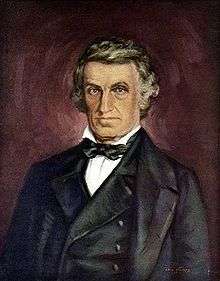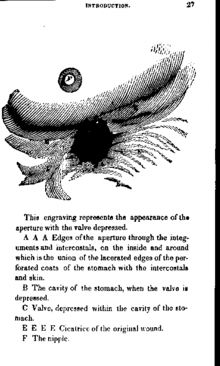William Beaumont
William Beaumont (November 21, 1785 – April 25, 1853) was a surgeon in the U.S. Army who became known as the "Father of Gastric Physiology" following his research on human digestion.[1][2]
William Beaumont | |
|---|---|
 William Beaumont | |
| Born | November 21, 1785 |
| Died | April 25, 1853 (aged 67) |
| Nationality | United States |
| Citizenship | United States |
| Known for | Research on digestion |
| Scientific career | |
| Fields | Medicine |
Biography
Early life
William Beaumont was born to Samuel Beaumont and Lucretia Abel in Lebanon, Connecticut; his father was a farmer.[3] He left his home after he turned twenty-one, moved to Champlain, New York and obtained a teaching job. In 1810 he relocated to St. Albans, Vermont where he trained to become a physician through an apprenticeship with Dr. Truman Powell. In June 1812, the Third Medical Society of the State of Vermont in Burlington examined his knowledge "on the anatomy of the human body, and the theory and practice of physic and surgery" and recommended him as "judicious and safe practitioner in the different avocations of the medical profession."[4]
From 1812 until 1815, Beaumont served as an assistant surgeon in the Army during the War of 1812 participating in the Battle of Plattsburgh.[4] After the war ended, he started a private practice in Plattsburgh, New York, but by 1820 Beaumont had rejoined the Army as a surgeon. He was assigned a location at Fort Mackinac. Beaumont took a leave in 1821, and married Deborah "Debby" Green Platt in Plattsburgh, before returning to his post. Deborah was divorced from Nathaniel Platt, whose uncle Zephaniah Platt founded Plattsburgh after the beginning of the Revolutionary War. Her father, Israel Green, was a third cousin of General Nathanael Greene.[5]
Experiments with St. Martin

On June 6, 1822, an employee of the American Fur Company on Mackinac Island, named Alexis St. Martin, was accidentally shot in the stomach by a discharge of a shotgun loaded with a buck shot from close range that injured his ribs and his stomach.[3]:102 Dr. Beaumont treated his wound, but expected St. Martin to die from his injuries.[6] Despite this dire prediction, St. Martin survived – but with a hole, or fistula, in his stomach that never fully healed. Unable to continue work for the American Fur Company, he was hired as a handyman by Dr. Beaumont.[7]
By August 1825, Beaumont had been relocated to Fort Niagara in New York, and Alexis St. Martin had come with him. Beaumont recognized that he had in St. Martin an unusual opportunity to observe digestive processes. Dr. Beaumont began to perform experiments on digestion using the stomach of St. Martin. Most of the experiments were conducted by tying a piece of food to a string and inserting it through the hole into St. Martin's stomach. Every few hours, Beaumont would remove the food and observe how well it had been digested. Beaumont also extracted a sample of gastric acid from St. Martin's stomach for analysis. In September, Alexis St. Martin ran away from Dr. Beaumont and moved to Canada, leaving Beaumont to concentrate on his duties as an army surgeon but Dr. Beaumont had him caught to continue to exhibit him. Beaumont also used samples of stomach acid taken out of St. Martin to "digest" bits of food in cups. This led to the important discovery that the stomach acid, and not solely the mashing, pounding and squeezing of the stomach, digests the food into nutrients the stomach can use; in other words, digestion was primarily a chemical process and not a mechanical one.[8]
During 1826 and 1827, Dr. Beaumont was stationed at Fort Howard in Green Bay, Wisconsin. In 1828 he was transferred to St. Louis, Missouri. While en route to St. Louis, Alexis St. Martin was ordered to stop at Fort Crawford in Prairie du Chien, Wisconsin, to serve as Dr. Beaumont's handyman again. In early 1831, Dr. Beaumont conducted another set of experiments on St. Martin's stomach, ranging from the simple observation of normal digestion to the effects that temperature, exercise and even emotions have on the digestive process.[9]
Beaumont published the account of his experiments in 1838, as Experiments and Observations on the Gastric Juice, and the Physiology of Digestion.[10] He and St. Martin parted ways, with Beaumont eventually going to St. Louis, Missouri, and St. Martin to his home in Quebec province, Canada. Off and on for the next twenty years, Beaumont tried to get St. Martin to move to St. Louis, but the move never occurred.[11]
Death
Beaumont died in 1853 in St. Louis, Missouri as a result of slipping on ice-covered steps. He was buried at Bellefontaine Cemetery.[12]
His papers are held at Washington University (St. Louis), School of Medicine, Library,[13] and copies are held at the National Library of Medicine.[1][14]
Legacy
Several institutions are named for William Beaumont, including:
- Beaumont High School in St. Louis, Missouri
- William Beaumont Hospital in Royal Oak, Michigan
- William Beaumont Hospital in Troy, Michigan
- William Beaumont Hospital in Grosse Pointe, Michigan (formerly Bon Secours Hospital, but merged into the Beaumont hospital system and renamed)
- William Beaumont Army Medical Center in El Paso, Texas (Dining Facility on the first floor of the hospital is named for Alexis St. Martin)
- Oakland University William Beaumont School of Medicine in the cities of Auburn Hills and Rochester Hills, MI.
- William Beaumont Elementary School in Waterford, Michigan is named in his honor.[15]
- Beaumont Highway, in Beaumont's hometown of Lebanon, was named in his honor.
- Beaumont Hall, which houses the Biology and Psychology programs at the State University of New York College at Plattsburgh, was named in his honor.[16]
In popular culture
- Beaumont's experiments on St. Martin were featured in a 2012 episode of Radiolab, which aired in on 2 April.[17]
- William Beaumont experiments on Alexis St. Martin were featured in a 2012 episode of Dark Matters: Twisted But True, which aired on Wednesday, August 1.
- A fictionalized history of complicated doctor–patient relationship between Beaumont and his patient St. Martin was recreated in a novel, Open Wound: The Tragic Obsession of Dr. William Beaumont (2011).[18]
- Beaumont experiments on St Martin were featured on the podcast "The Dollop with Dave Anthony and Gareth Reynolds" 33 The Stomach Men (11/15/14)[19]
- The relationship between Beaumont and St. Martin and their experiments are recounted by Dr. Sydnee McElroy and her husband Justin McElroy on their medical podcast Sawbones, in the episode, The Gut Hole Romance (5/13/2015), hosted by the Maximum Fun network.[20]
- The story of Beaumont's treatment of and experiments on St. Martin were reenacted on the medical drama Medic, which aired on Feb 27, 1956.[21]
See also
- Alexis St. Martin - Beaumont's most notable patient
Selected writings
- Beaumont, William. "Experiments and Observations on the Gastric Juice and the Physiology of Digestion." Plattsburgh: FF Allen, 1833.
- Beaumont, William. "Experiments and Observations on the Gastric Juice and the Physiology of Digestion." Maclachlan and Stewart (Edinburgh), 1838.
References
- William Beaumont Papers (1812-1959), National Library of Medicine
-

- Myer, Jesse S. (editor) (1912). Life and Letters of Dr. William Beaumont. St. Louis: C. V. Mosby Company. ISBN 978-0-8016-0535-2.CS1 maint: extra text: authors list (link)
- Dempster, James Herbert. Pathfinders of Physiology, The Deitroit Medical Journal Company, 1914, p. 25.
- "William Beaumont Family Genealogy". www.james.com.
- Beaumont, William (1838). Experiments and Observations on the Gastric Juice and the Physiology of Digestion. Edinburgh: Maclachlan and Stewart. ISBN 978-0-486-69213-5.
- Harré, R. (1981). Great Scientific Experiments. Phaidon (Oxford). pp. 39–47. ISBN 978-0-7148-2096-5.
- "William Beaumont Biography - life, family, death, young, book, information, born, house, time". www.notablebiographies.com.
- Martin, Deborah Beaumont (1921). "Doctor William Beaumont: His Life in Mackinac and Wisconsin, 1820-1834". The Wisconsin Magazine of History. 4 (3): 263–280. JSTOR 4630308.
- Beaumont, William (1929). Experiments and Observations on the Gastric Juice and the Physiology of Digestion.
- "The Gruesome Medical Breakthrough of Dr. William Beaumont on Mackinac Island". MyNorth.com. May 18, 2017.
- "Story Time - Beaumont & Digestion". peer.tamu.edu.
- "Search". digitalcommons.wustl.edu.
- Pizer, IH (1964). "SOURCE MATERIALS AND THE LIBRARY: THE DISPERSION OF THE BEAUMONT PAPERS". Bull Med Libr Assoc. 52: 328–36. PMC 198118. PMID 14119306.
- "William Beaumont Elementary School, Waterford, Michigan".
- "Plattsburgh State Summer Update". Plattsburgh State Office of College Relations. 18 July 1973. Retrieved 17 January 2019.
- Radiolab: "Guts: Holey Cow." WNYC, April 2, 2012. Retrieved 2012-09-30.
- Abigail Zuger, M.D. Doctor and Patient, Bound by Mutual Dependency, The New York Times, November 28, 2011.
- Carla (Jun 5, 2015). "Episode 33: Dollop: The Stomach Men » The Dollop Dot Net".
- Sawbones: "The Gut Hole Romance." May 13th, 2014.
- IMDB
Further reading
- Beaumont, W. (June 1977). "Nutrition Classics. Experiments and observations on the gastric juice and the physiology of digestion. By William Beaumont. Plattsburgh. Printed by F. P. Allen. 1833". Nutr. Rev. 35 (6): 144–5. doi:10.1111/j.1753-4887.1977.tb06570.x. hdl:2027/hvd.32044011333382. ISSN 0029-6643. PMID 327355.
- Brodman, E. (1964). "Scientific and Editorial Relationships between Joseph Lovell and William Beaumont". Bulletin of the History of Medicine. 38: 127–32. ISSN 0007-5140. PMID 14132124.
- Cummiskey, R. D.; O'Leary J. P. (August 1996). "William Beaumont". The American Surgeon. 62 (8): 690–1. ISSN 0003-1348. PMID 8712571.
- Dubois, A.; Johnson L. F. (December 1985). "William Beaumont: frontier physician and founding father of gastric physiology". J. Clin. Gastroenterol. 7 (6): 472–4. doi:10.1097/00004836-198512000-00005. PMID 3910708.
- Field, W. (December 1985). "An original Beaumont letter". J. Clin. Gastroenterol. 7 (6): 475–6. doi:10.1097/00004836-198512000-00006. PMID 3910709.
- Harré, R. (1981). Great Scientific Experiments. Phaidon (Oxford). p. 39. ISBN 978-0-19-286036-1.
- Mai, F. M. (October 1988). "Beaumont's contribution to gastric psychophysiology: a reappraisal". Canadian Journal of Psychiatry. 33 (7): 650–3. doi:10.1177/070674378803300715. ISSN 0706-7437. PMID 3058293.
- Modlin, I. M. (September 1999). "A gastric sexology: the story of three men and three bottles of gastric juice". J. Clin. Gastroenterol. 29 (2): 111–4. doi:10.1097/00004836-199909000-00001. PMID 10478867.
- Life and Letters of Dr. William Beaumont Jesse S. Myer (editor), C. V. Mosby Company (St. Louis), 1912.
- Nelson, Rodney B. (1990), Beaumont: America's First Physiologist, Geneva, Illinois: Grant House Press.
- O'Leary, J. P. (January 1994). "The identification of the caustic agent in gastric juice". The American Surgeon. 60 (1): 79–80. ISSN 0003-1348. PMID 8273980.
- Palmer, W. L. (October 1953). "Centennial of the death of William Beaumont, 1785-1853". Gastroenterology. 25 (2): 113–8. doi:10.1016/S0016-5085(19)36255-9. ISSN 0016-5085. PMID 13107912.
- Rutkow, I. M. (November 1998). "Beaumont and St Martin: a blast from the past". Archives of Surgery. 133 (11): 1259. doi:10.1001/archsurg.133.11.1259. PMID 9820364.
- Schatzki, S. C. (June 1993). "Beaumont and St. Martin". AJR. American Journal of Roentgenology. 160 (6): 1176. doi:10.2214/ajr.160.6.8498211. ISSN 0361-803X. PMID 8498211.
- Smith, A. H. (May 1951). "William Beaumont (November 21, 1785-April 25, 1853)". J. Nutr. 44 (1): 3–16. doi:10.1093/jn/44.1.1. ISSN 0022-3166. PMID 14851070.
- The Case of the Wounded Woodsman and His Dedicated Physician Albert B. Lowenfels, MD; 09/02/2009
External links
| Wikisource has the text of an 1879 American Cyclopædia article about William Beaumont. |
- William Beaumont at Find a Grave
- Life of Dr. William Beaumont
- William Beaumont Papers (1812-1959), National Library of Medicine